Branding & Visual Studies: Foundations and Research
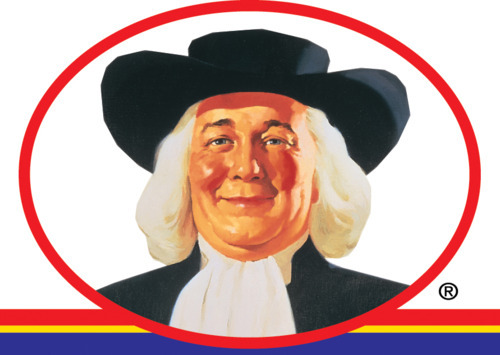

Above, top to bottom: Quaker Oats mascot; Sealand identity proposal by Metahaven.
Almost two years ago, I was asked by SVA MPS Branding Chair Debbie Millman and Co-Founder Steven Heller to teach a course for the new program, which kicked off its inaugural year this September. Over the months leading up to the program’s launch, I had the opportunity to immerse myself in research and to seek out the opinions of fellow faculty as I prepared this class. I am grateful for their contributions, and for the smart and hardworking students that enrolled in the course. I couldn’t have asked for a better group, and their contributions deepened and amplified the themes I’ve laid out here at every turn. I found few resources online for assembling a class of this kind, yet its topics seem to infuse our contemporary discussions of design and identity. I offer the syllabus here as an evolving document and will be adding to it myself over time. I welcome suggestions for additions as well. —RG
Course description: Beginning with the history and underlying ideas of branding and identity design, this course will examine the development of classic identities as well as seminal identity designers and design studios. We will also review contemporary cases that highlight the challenges of brand and identity creation in specific sectors including fast-moving consumer goods, durable goods, services, organizations, places, and ideas. At the same time, we will examine both critical viewpoints around the practice of identity design and speculate on the future of brands and branded environments.
Above all, this course will:
- Educate and train your eyes
- Ask you to observe, evaluate, and critique basic claims and assumptions
- Provide you with a platform for research
Guest lecturers: Guest lectures by contemporary practitioners will complement our coursework. This semester, we will welcome:
- Dmitri Siegel, Executive Director of Marketing, Urban Outfitters
- Matt Wishnow, SVP D2C, Warner Music Group; Founder, Insound
- Randy J. Hunt, Design Director, Etsy
- Albert Lee, Portfolio Lead, IDEO New York
Class blog: Our class blog is a place to continue discussion, debate, and sharing outside of our weekly class meeting. You will be required to submit three kinds of short posts to the blog:
- Image posts: Select an image drawn either from our current coursework or from your own ongoing research. Write a short description about this image, what it is, how you see it, why you find it interesting, etc.
- Material posts: Select a reading, link, or video related to our focus in class that week along and write a short note about its connection with our coursework.
- Discussion posts: Generate five questions or comments for discussion in next week’s class related to that week’s reading material.
Please tag your posts with your name to get credit and plan to monitor the blog closely to keep current with your classmates’ posts.
Instructional format: This course will employ a variety of formats including group presentations, individual presentations, discussions, lectures, and working sessions. When appropriate, video or other supplemental materials will be used. Students are strongly encouraged to take part in class discussions and in their own working groups. Working groups will be assigned early in the semester and will remain together for all group projects.
Projects and evaluation: Students are required to attend every scheduled class meeting, complete all required readings, participate actively in class discussions, and collaborate effectively in an assigned working group. Individual work, group work, and in-class participation will be evaluated using a four-point rubric (Beginning = 1, Developing = 2, Accomplished = 3, Exemplary = 4). Course grades are pass/fail but rubric evaluations will be available upon student request at the midterm and final class. At the end of the semester, group project slides and notes should be collected as a set of PDFs and handed in. Individual projects should be emailed as PDFs as well. All tagged blog posts will also be considered in the final evaluation.
Classes
- Class 1: Myths and meanings
- Class 2: Taxonomies
- Class 3: Clarity and confusion
- Classes 4 & 5: Practitioner groups
- Classes 6 & 7: Market sectors
- Class 8: Futures
Class 1: Myths and meanings
Summary: I started the class by looking at a wide spectrum of definitions of branding, and sorted them into four categories. Simple definitions took the form of “Branding is [blank],” reflective definitions suggested the brand was a kind of mirror for the internal dynamics of either a company or its consumer base, metaphorical definitions took this took this idea of the “brand as [blank]” and pushed them even further, and, finally, there are negative definitions, which often suggest that banding is not what you think it is. Like all definitions, each claim says as much about the claimant’s position as it does about the practice of branding itself.
We then looked at branding through more historical lens, suggesting that what has come to be known as branding can also be seen as the merging and mixing of four earlier professions: marketing, advertising, public relations, and graphic design. What triggered these disciplines to start to merge? One answer might come from looking at a shift in business itself: businesses, particularly fast-moving consumer goods like packaged food, realized it was ultimately more valuable to own the means of representing a product than it was to own the means of producing a product. Thus a company’s assets moved from tangible assets, or physical capital, to intangible assets, or intellectual captial.
Throughout the semester, we returned to this remark by John Stuart, Chairman of Quaker Oats (1900), which I introduced in this first class:
If this company were to split up, I would give you the property, plant and equipment, and I would take the brands and the trademarks — and I would fare better than you.
Stuart realized as early as the turn of the 20th century that the image of his smiling Quaker was worth more than any of his mills.
We went on to view branding not just through the merging of various professions but also through the lens of various academic disciplines like semiotics, economics, psychology, and anthropology. And finally, we saw the products of branding and identity design — symbols, logos, colors, etc. — as not a single but a varied set of signs, including marks of ownership (cattle brands), marks of affiliation (club insignias), marks of nationality (flags), marks of autheticity or maker’s marks (ceramic stamps), marks of reputation or rank (four-star general), and marks of aspiration (luxury brands), which typically have evolved out of one of the preceding mark categories.
I then posed several questions about the future of identity design:
- How can an identity function not as a solution but as a framework? How can it function less like a building and more like a masterplan?
- How can an identity remain simple and flexible enough to generate new implementations?
- How do time and collaboration yield successive variations? How can these differences be productive?
The first question prompted a connection to Stuart Brand’s famous concept of a building’s “shearing layers” that suggest a single building is changing at various speeds all at once.
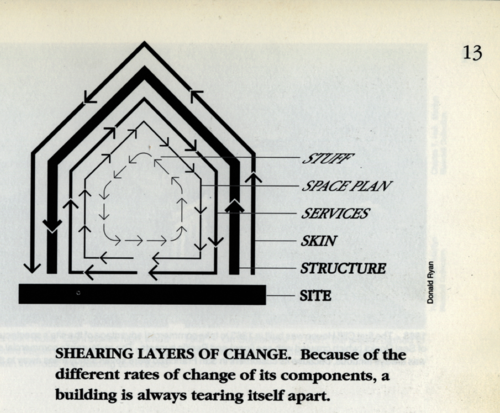
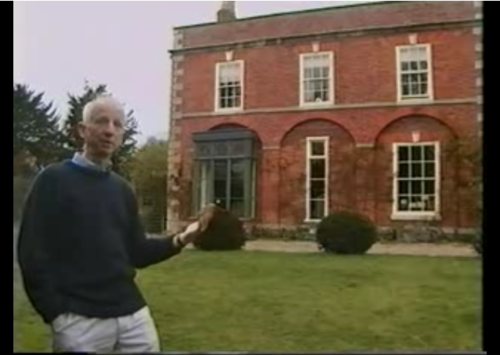
Above, top to bottom: Graphic from How Buildings Learn by Stuart Brand. The sixth installment of Brand’s BBC series of the same name.
The second question prompted a look back to an earlier talk I’d given at Artists Space on the evolution of its A monogram from the institution’s founding in ’70s to its current iteration today by designer Manuel Raeder.

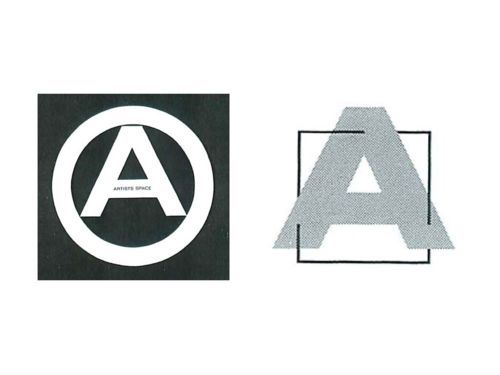
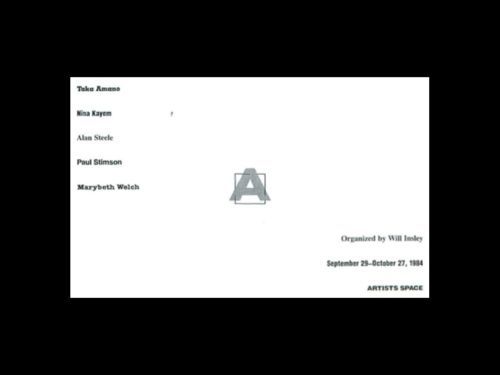
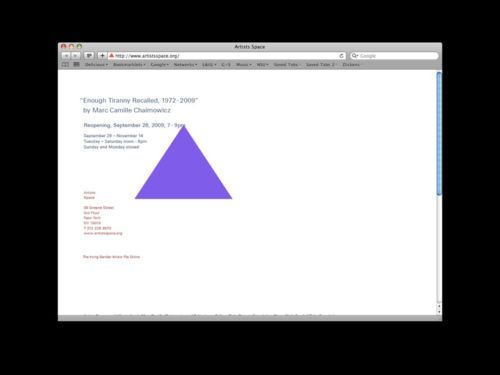
Above, from top: An early Artists Space monogram; marks from the early- to mid-’80s; a mailer from 1984; the Artists Space website in 2010.
The third question prompted a reference to art historian George Kubler, who, rather than looking at art objects on an individual basis, tried to position each object within a lineage of objects that are formally related to it, influenced by it, and influences on it. Kubler’s method blurs the boundaries between objects and treats them more like ideas captured at a certain moment, the way a page on Wikipedia is both static and evolving at the same time. This all-at-once-ness is present in the wonderful example of Knopf’s Borzoi dog, who takes many forms, each of which was made at a certain point for a certain reason by a variety of designers, all of which signal that the book is a Knopf book, and whose selection is somewhat conditional on the type of book Knopf is publishing in that case. Thus a Knopf book may be described as “a book with a dog on it,” and this description alone, though loose, is sufficient to mark it as a Knopf book.
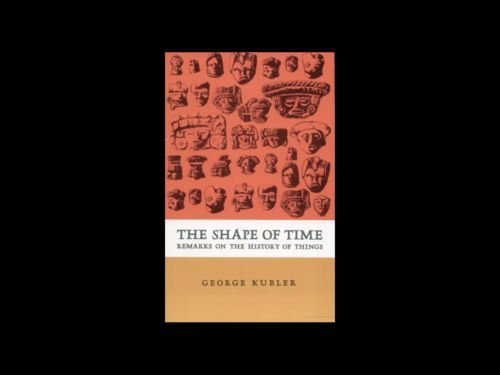
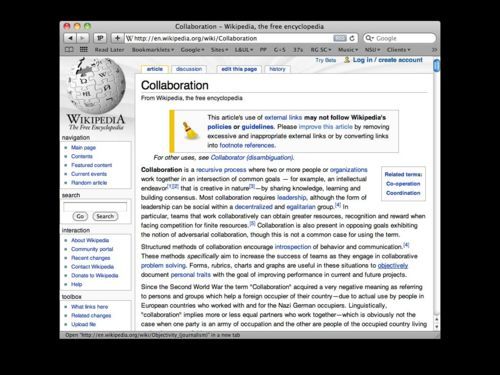
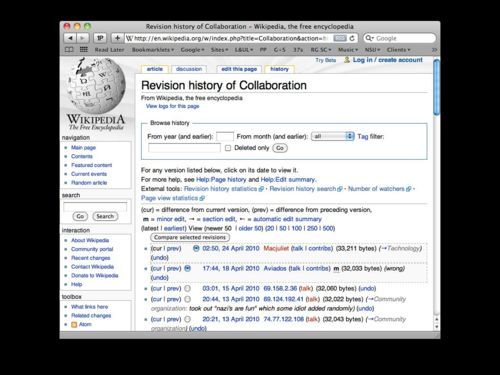
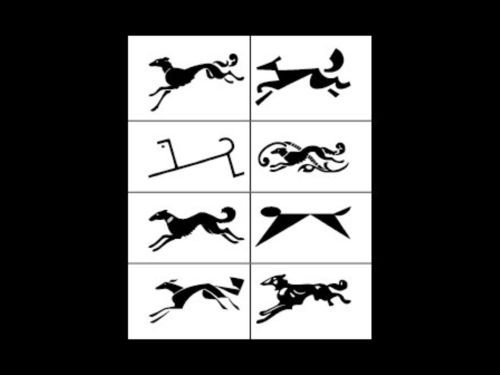
Above, from top: The cover of Kubler’s The Shape of Time; the Wikipedia page for “Collaboration” and the history of its modification; a selection of Knopf Borzoi marks.
In-class project: Pick five brands that you identify with; discuss your thinking with the class. (30 mins)
Individual project: Using one of the five brands you identified in class, write a letter to Roland Barthes; come to class next week prepared to read and discuss your letter. (5-10 mins)
Rubric: Understanding of Barthes, engagement with chosen brand, quality of writing
Reading
- Roland Barthes: “The Eiffel Tower” from The Eiffel Tower and Other Mythologies
- Roland Barthes: “Toys,” “Plastic,” “Soap-powders and detergents” from Mythologies
- Douglas B. Holt: Chapters 3 & 8 from How Brands Become Icons
Class 2: Taxonomies
Summary: In this session I introduced the idea of taxonomies as a tool for visually organizing many of the marks we see. Taxonomies involve two simple activities that come naturally to designers: classing and ordering. Heterogeneous things are classed into common sets and those common sets are ordered into a hierarchical scheme. The Animal Kingdom, which moves from kingdom to species, is a good example. As you move up the chain, you get increasingly specific.
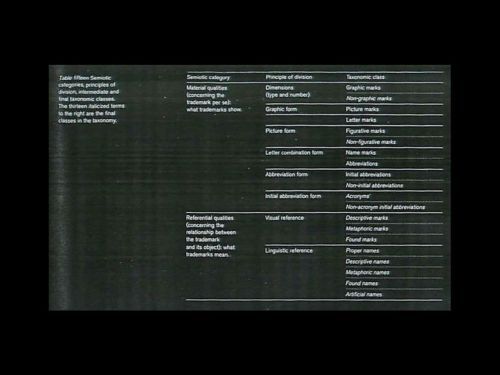
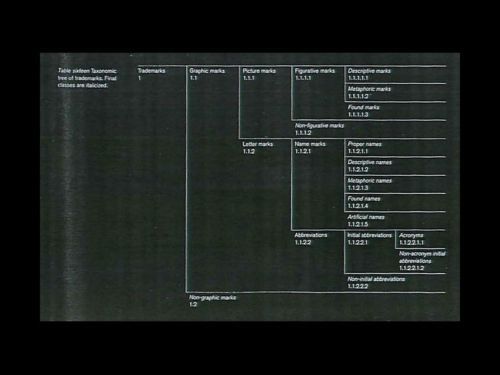
Above: Taxonometric classes (top) ordered into a hierarchical table (bottom) from Per Mollerup’s book Marks of Excellence.
We looked at a few different ways of creating taxonomies within identity design, from playful (Tibor Kalman’s “A New Identity” for Print Magazine), to basic (Elinor Selame’s 1975 chart of symbol types) to complex (Per Mollerup’s classification system). As we did, we discussed some of the assumptions these charts made, and what kinds of other systems might be open to exploration.
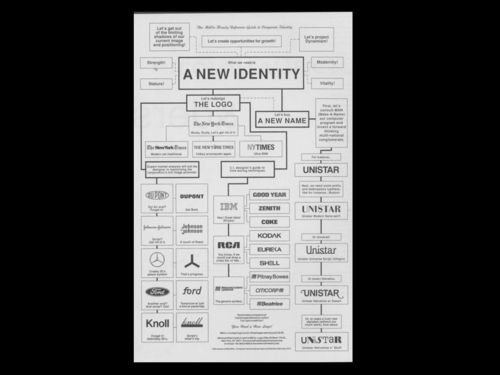
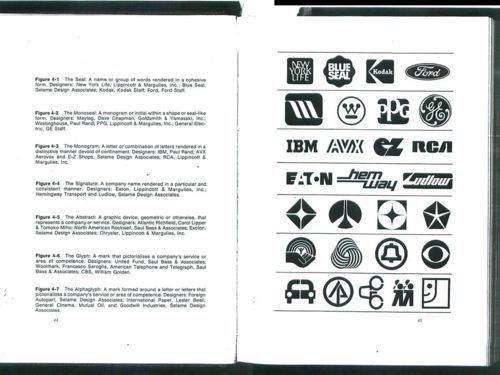
Above, from top to bottom: Tibor Kalman’s “A New Identity” flowchart taxonomy for Print Magazine, reproduced in Perverse Optimist. Elinor Selame’s chart of symbol types from her book Developing a Corporate Identity
Finally, we discussed some different ways companies organize their own brands. With the help of some taxonomies prepared by Australia’s Blueprint Advisory, we organized these strategies into “uniform” brand strategies (like BMW’s), “endorsed” brand strategies (like Apple’s iPod), “variable” brand strategies (like P&G’s Gilette, Clarol, Cascade, and more), and “hybrid” stratgies that combine elements of each. While uniform strategies work well for durable goods like cars and services like air travel, “variable” strategies work well for fast-moving consumer goods to aid in consumer recall and differentiation.
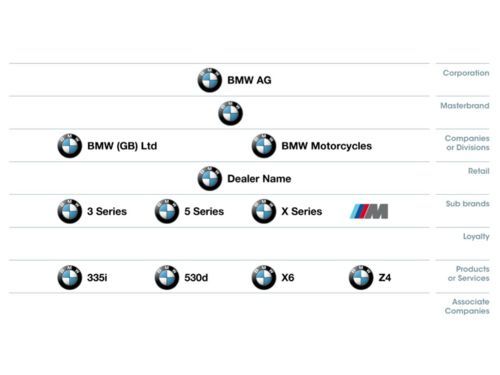
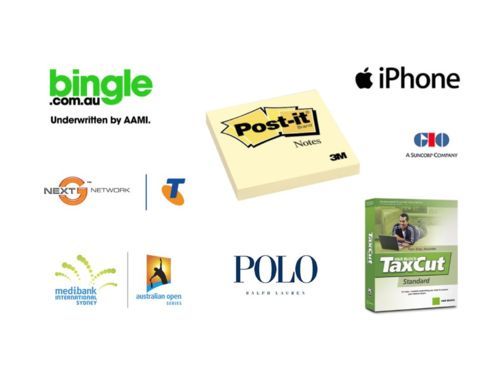
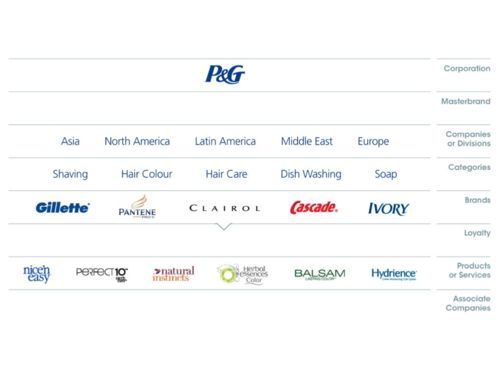
Above, from top to bottom: “Uniform,” “Endorsed,” and “Variable” brand strategy charts by Blueprint Advisory.
Individual project: A taxonomy is a hierarchical classification scheme useful in simplifying or abstracting a large set of varied data. For next week, your task is to collect 50+ varied logos and propose a taxonomy to organize them. While the logos in your collection will necessarily inform the taxonomy you construct, do not be overly literal in your conclusions. Logos that are all one form, logos from a single industry, etc are simply catagorical; they are not taxonometric. Also, while ambitious or even fantastical taxonomies are welcome, be sure to come to class ready to support your claims with solid arguments. (10 mins)
Rubric: Good collection, well-organized taxonomy, assertions supported with well-crafted arguments
Reading
- Per Mollerup: Chapter 1 from Marks of Excellence
- Karl Gerstner: “Logos and labels” from Visual Language
- Paul Rand: “Logos, flags, and escutcheons” from Design, Form, and Chaos
- Bruce Mau: “Audition” from Life Style
- Hans Weckerle: “Typographer as analyst” from Design
Class 3: Clarity and confusion
Group project: Using brands from Kevin Clancy and Jack Trout’s Harvard Business Review article on “Brand Confusion” as a starting-point, select a pair of brands often confused for one another and research their histories, their present-day visual identities, and their market positioning. From this research, propose at least five actionable steps one or both brands could take to help mitigate consumer confusion and, potentially, increase market overall share. (20 mins)
Rubric: Quality of research into brand histories, strength of arguments, overall presentation and group effort
Reading
- Barry Schwartz: TED Talk [Video]
- Malcolm Gladwell: “The Ketchup Conundrum” from The New Yorker
- Nicholas Lemann: “The Word Lab” from The New Yorker
Classes 4 & 5: Practitioner groups
Group project: Prepare a profile and portfolio selection for a significant practitioner of visual branding and identity design. This could be anyone: individuals (Paul Rand, Saul Bass), design firms (Pentagram, IDEO, Chermayeff & Geissmar, M&Co), industry giants (Landor, Wolff Olins, Siegel & Gale, Interbrand, Futurebrand, Lippencott), boutiques (Lloyd, Baron & Baron, A+R, Saffron), advertising agencies (Wieden+Kennedy, Saatchi & Saatchi), even in-house departments (Target, CBS). Along with preparing a representative selection of these firms’ work, you should be ready to offer your analysis each group’s impact and overall philosophy. (20 mins)
Rubric: Breadth of survey, quality of visual and factual research, depth of insight, conclusions, and take-aways, overall presentation and group effort
Reading
- Wally Olins: Chapters 1–4 from The Corporate Personality
- Phillip Meggs: Chapter 22 from Meggs’s History of Graphic Design
- Thomas Frank: Chapter 1 from The Conquest of Cool
- Metahaven: Intro Riff & Chapter 1 from Uncorporate Identity
Classes 6 & 7: Market sectors
Group project: Fast-moving consumer goods, durable goods, services, organizations, places, and ideas together comprise the six broad sectors of branding. Within each of these sectors there are several subsectors as well; organizations, for example, include not just corporations but also governments, NGOs, universities, churches, and museums to name a few. Consider each of these subsectors in your analysis, survey representative brands in each subsector, and then gather and analyze these brands’ visual assets and communication strategies in order to draw conclusions about the particular challenges faced by both the subsector, and, more broadly, the sector as a whole. (20 mins)
Rubric: Breadth of survey, quality of visual and factual research, depth of insight, conclusions, and take-aways, overall presentation and group effort
Reading
- Judith Williamson: “Magic” from Decoding Advertisements
- Raymond Williams: “Advertising: The Magic System” from Culture and Materialism
- John Berger: Chapter 7 from Ways of Seeing
- Daniel Boorstin: Introduction & Chapter 5 from The Image
- Rotterdam 2001: Introduction and presentation by Mevis & Van Deursen from Identities
- Dexter Sinister: “We would like to share”
Class 8: Futures
Individual project: As thoughtfully as you can, tell us what’s next, what’s coming, what’s on the horizon. What areas of opportunity do you see opening up? How will branding change in the next five years? How about the next ten? How can brands take advantage of this? How can customers? What sort of visual forms, systems, and strategies could be around the corner? What are pitfalls, dangers, and how can we plan for them? What are some risks worth taking? Where are there new opportunities? Take care to be persuasive and support your claims with facts, statistics, supporting visuals, and memorable take-aways. Consider this a pitch. (5 mins)
Rubric: Use of course materials in preparing presentation, big ideas presented in an accessible way, focus and polish in presentation, conclusions and thoughts future action or study
Further readings and resources
Images
Books
- Alina Wheeler: Designing Brand Identity
- Al Ries and Jack Trout: Positioning: The Battle for Your Mind
- Al Ries and Laura Ries: The 22 Immutable Laws of Branding
- Andres Janser and Barbara Junod: Corporate Diversity: Swiss Graphic Design and Advertising by Geigy 1940 to 1970
- B. Joseph Pine and James H. Gilmore: The Experience Economy: Work Is Theater & Every Business a Stage
- Chuihua Judy Chung, Jeffrey Inaba, Rem Koolhaas, and Sze Tsung Leong (editors): The Harvard Design School Guide to Shopping
- Dan Friedman: Radical Modernism
- Ellen Lupton and J. Abbott Miller: “Subliminal Seduction” and “Low and High” from Design Writing Research
- George A. Akerlof and Rachel E. Kranton: Identity Economics: How Our Identities Shape Our Work, Wages, and Well-Being
- Jan Conradi: Unimark International: The Design of Business and the Business of Design
- Joe Duffy: Brand Apart
- Jon Miller and David Muir: The Business of Brands
- Lars Thøger Christensen and George Cheney: “Self-Absorption and Self-Seduction in the Corporate Identity Game” from The Expressive Organization: Linking Identity, Reputation, and the Corporate Brand
- Matthew Healey: What is Branding?
- Melissa Aronczyk and Devon Powers: Blowing up the Brand
- Nancy Koehn: Brand New: How entrepreneurs earned consumers’ trust from Wedgwood to Dell
- Paul Willis: “Symbolic Creativity” from The Everyday Life Reader
- Rita Clifton (editor): Chapters 1, 4 & 7 from Brands & Branding (The Economist)
- Rob Walker: Buying In
- Roland Marchand: “AT&T: The Vision of a Loved Monopoly” from Creating the Corporate Soul: The Rise of Public Relations and Corporate Imagery in American Big Business
- Scott Lash and John Urry: Economies of Signs and Space
- Steven Connor: “Rough Magic: Bags” from The Everyday Life Reader
- Thomas Watson, Jr.: “Good Design is Good Business” from The Uneasy Coalition: Design in Corporate America
- Tom Calkins and Alice Tybout (editors): Kellogg on Branding
- Wally Olins: “How Brands are Taking over the Corporation” from The Expressive Organization: Linking Identity, Reputation, and the Corporate Brand
Videos
- ABC Nightline: “Ideo redesigns the shopping cart”
- Bruce Mau: “Interview with Charlie Rose”
- Joe Duffy: From “Thirty Conversations on Design”
- Mickey Drexler: “Interview with Charlie Rose”
- Naomi Kline: “CBC: Hot Type Interview”
- PBS Frontline: “The Persuaders”
- Robin Chase: “Zipcar and the next big idea”
- Sol Sender: “Designing Obama”
- Steve Jobs: “Apple’s approach to branding”
- Tim Westergren: “Interview with Charlie Rose”
- Wally Olins: “The Nation And The Brand And The Nation As A Brand”
Online articles and resources
- Adam Arvidsson: “The Logic of the Brand”
- Adam Sternbergh: “Up with Grups”
- Alex Santoso: Evolution of Car Logos
- Armin Vit: Coke vs Pepsi, Revised Edition
- Armin Vit and Bryony Gomez-Palacio: “The Secret Design History of 12 Famous Brands”
- Christopher Locke, Rick Levine, Doc Searles and David Weinberger: The Cluetrain Manifesto: The End of Business as Usual
- Corporate Identity: Corporate Identity Catalogue
- Daniel Eatock: Boymeetsgirl Identity
- Danielle Sacks: Crack This Code
- Dmitri Siegel: “Design by Numbers”
- Dmitri Siegel: “Message on a bottle [PDF]”
- Doblin: Innovation Planning
- Douglas B. Holt: The Problem with Viral Branding
- Greg Beato: Twenty-Five Years of Post-it Notes
- Guy Debord: The Society of the Spectacle
- Harish B Nair: Brand Laddering
- Hartman Group: Bad Economy or Bad Brands?
- Harvard Business Review: Interview with Howard Schultz
- Henri Weijo: Branding History and Mind-Share, Emotional, and Viral Branding
- Idriss Mootee: Developing Brand Strategy
- Interbrand: The Most Valuable U.S. Retail Brands 2009
- James Bowie: The Lucent Logo Legacy: Long Live the Big Red Donut
- John Deighton: How a Juicy Brand Came Back to Life
- John Emerson: The Social Role of the Graphic Designer
- John O’Reilly: The floating signifier
- Joshua Porter: “Leveraging Cognitive Bias in Social Design”
- Joshua Porter: “Metrics-Driven Design”
- Kevin Henry: The Shape of Things: Vilém Flusser and The Open Challenges of Form [PDF]
- Majken Schultz and Mary Jo Hatch: The Cycles of Corporate Branding: The Case of the LEGO Company [PDF]
- Marty Neumeier: The Brand Gap
- Matt Rubel: How To Reinvigorate Old Brands
- Michael Bierut: “Authenticity: A User’s Guide”
- Michael Bierut: Designing the Unthinkable
- Michael Bierut: Better Nation Building Through Design
- Michael Bierut: The Graphic Design Olympics
- Michael Bierut: Looking for Celebration, Florida
- Michael Bierut: Every New Yorker is a Target
- Michael Bierut: The Final Days of AT&T
- Michael Bierut: Innovation is the New Black
- Michael Bierut: In Praise of Slow Design
- Michael Bierut: The Mysterious Power of Context
- Michael Bierut: Donal McLaughlin’s Little Button
- Michael Bierut: Invasion of the Neutered Sprites
- Neville Brody: Design Insurgency
- Noam Cohen: The Power of the Brand as Verb
- On the Media: Character Matters
- On the Media: Absolut Exhaustion
- Ouke Arts: 10 New Business Models for this Decade
- Philip R.P. Coelho, Daniel B. Klein, James E. McClure: Fashion Cycles in Economics [PDF]
- Reed Hastings: Netflix Business Opportunity
- Richard Benson: Flexible friends
- Rick Turoczy: The name game
- Sarah Mitchell: Summary of Nudge, presented to IxDA LA
- Samuel M. McClure, Jian Li, Damon Tomlin, Kim S. Cypert, Latané M. Montague and P. Read Montague: Neural Correlates of Behavioral Preference for Culturally Familiar Drinks [PDF]
- Steven Heller: Cooper Union’s New Logo
- Stuart Hall: Encoding, Decoding [PDF]
- Theodor Adorno and Max Horkheimer: The Culture Industry: Enlightenment as Mass Deception
- Tibor Kalman and Karrie Jacobs: We’re here to be bad
- Tim Kitchin: Ethical Consumers, Simplux brands and Social Communication
- Tony Spaeth: Sign Language [PDF]
- Wally Olins: Branding the Nation [PDF]
- Wally Olins: The Image of Spain [PDF]
- Wikipedia: Frame analysis
- Wikipedia: Imagined communities
- Wikipedia: Louis Cheskin
- Wikipedia: Scenario planning
- Wikipedia: SWOT analysis